CGR1240 to IR8140 Migration Guide
This document contains high level END USER requirements for migration from CGR to IR8100.
Introduction
This document describes end customer requirements and differences that should be understood when migrating from CGR1240 to IR8140 deployments. The configuration of SNI (Secure Network Infrastructure) that supports ZTD (Zero Touch Deployment) and operations of the router in the field are remarkably similar. However, there are differences that need to be addressed for a successful deployment of IR8140 as a replacement or in addition to the CGR1240 deployments.
Hardware Differences: IR8140 vs CGR1000
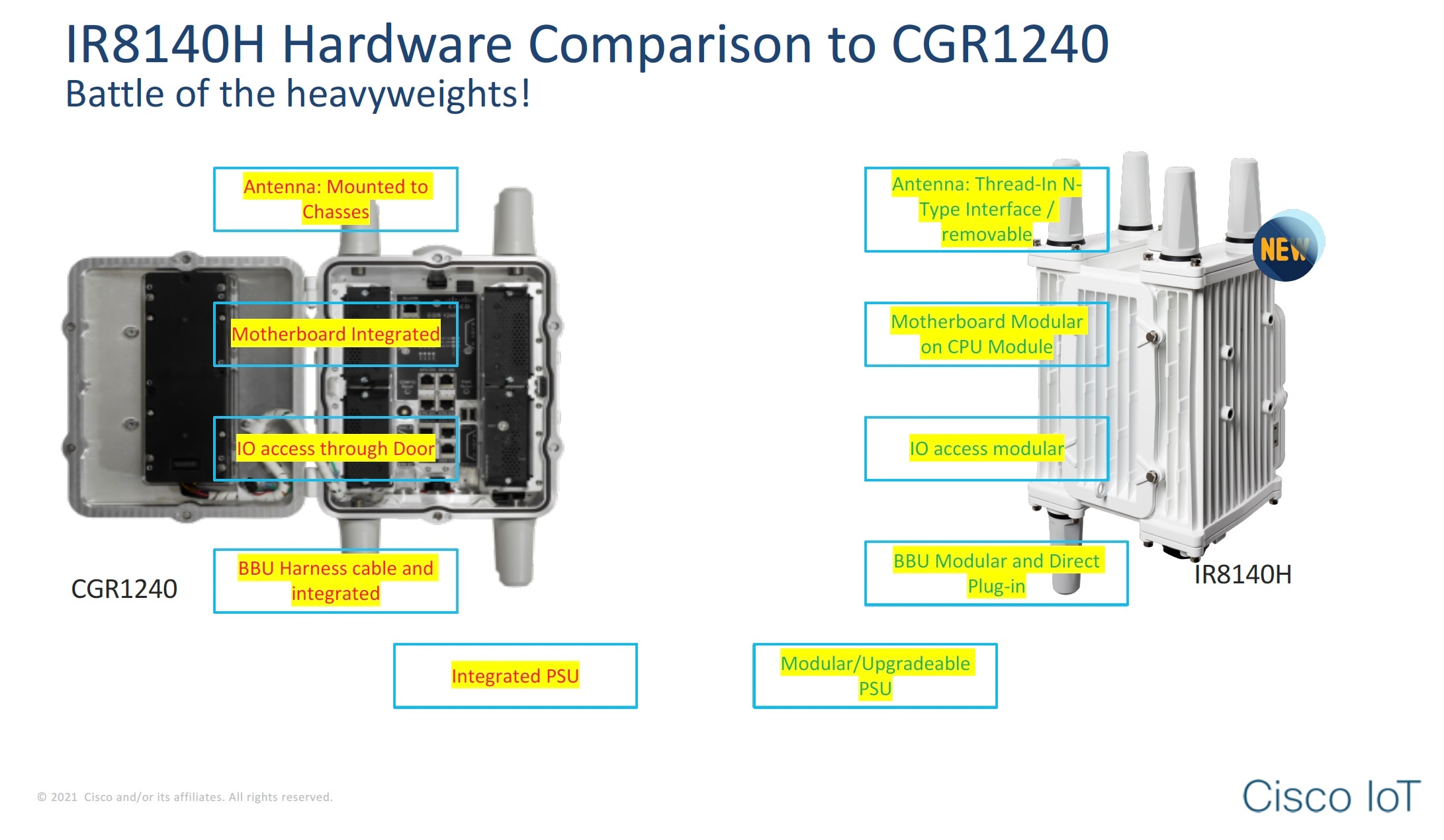
IMPORTANT: The IR8140 chassis can be deployed onto existing CGR1240 pole mount brackets.
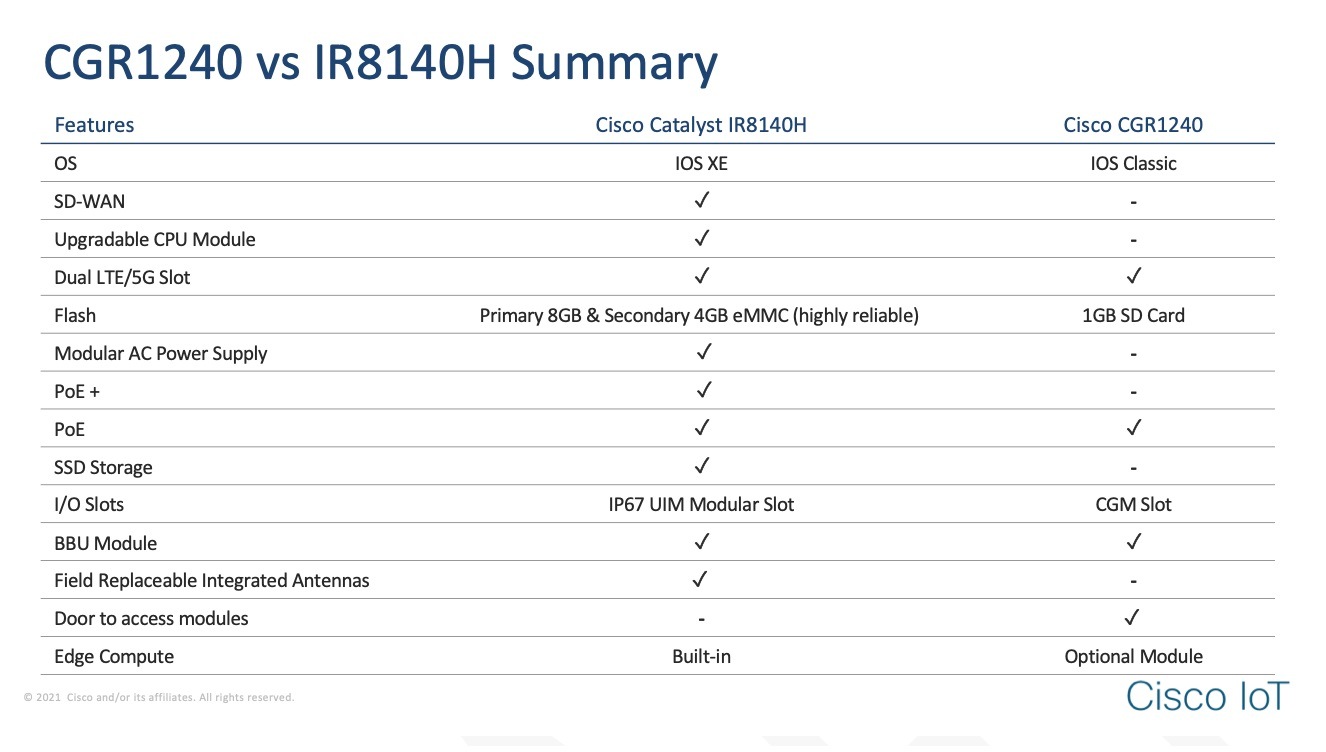
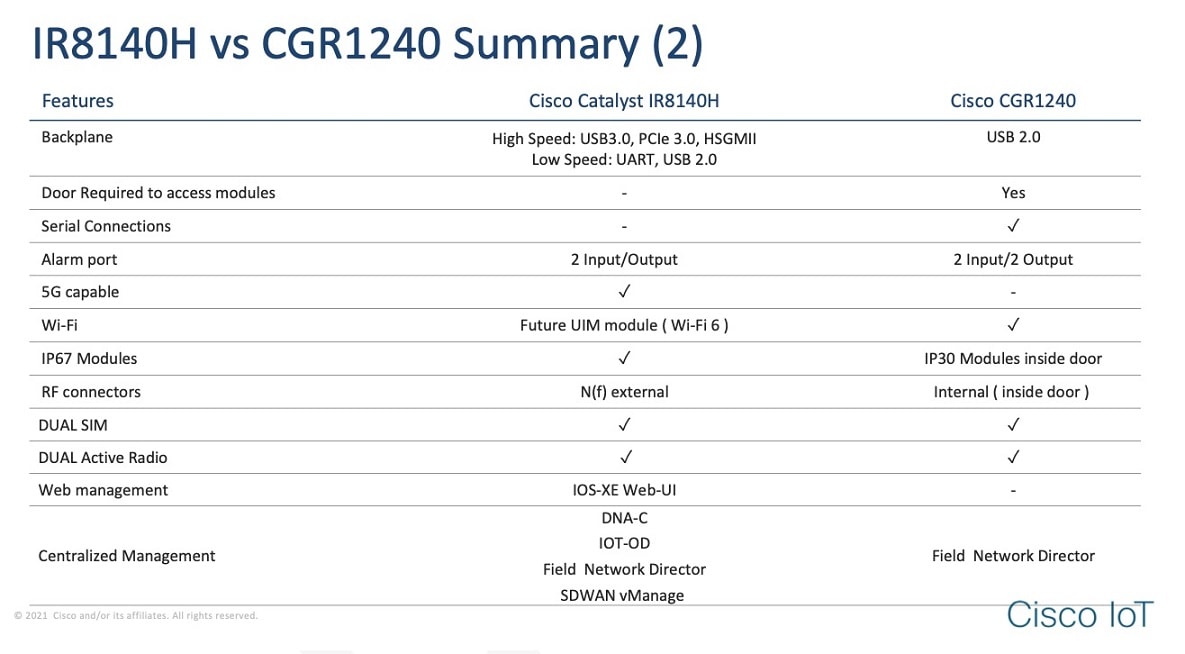
|
CGR1240 |
IR8140H |
|
|---|---|---|
|
Fixed Interfaces |
GigabitEthernet0/1, FastEthernet2/3 – 6, GigabitEthernet2/1 – 2 Dot11Radio2/1 |
GigabitEthernet0/0/0 GigabitEthernet0/0/1 |
|
Modular interfaces |
Cellular 2-4/1 WPAN 2-4/1 |
Cellular 0/1-3/0 WPAN 0/1-3/0 |
IR8140 Hardware Overview
A disassembled IR8140 is shown in Figure 1. These figures show the front and back views of a IR8140 ready for final module insertion such as the Cellular module shown in Figure 4. This unit is assembled to fit the customer’s specifications and has been tested for basic hardware functionality. The system is ready for configuration. For more details about IR8140H hardware, see the Cisco Catalyst IR8140 Heavy Duty Router Installation Guide.
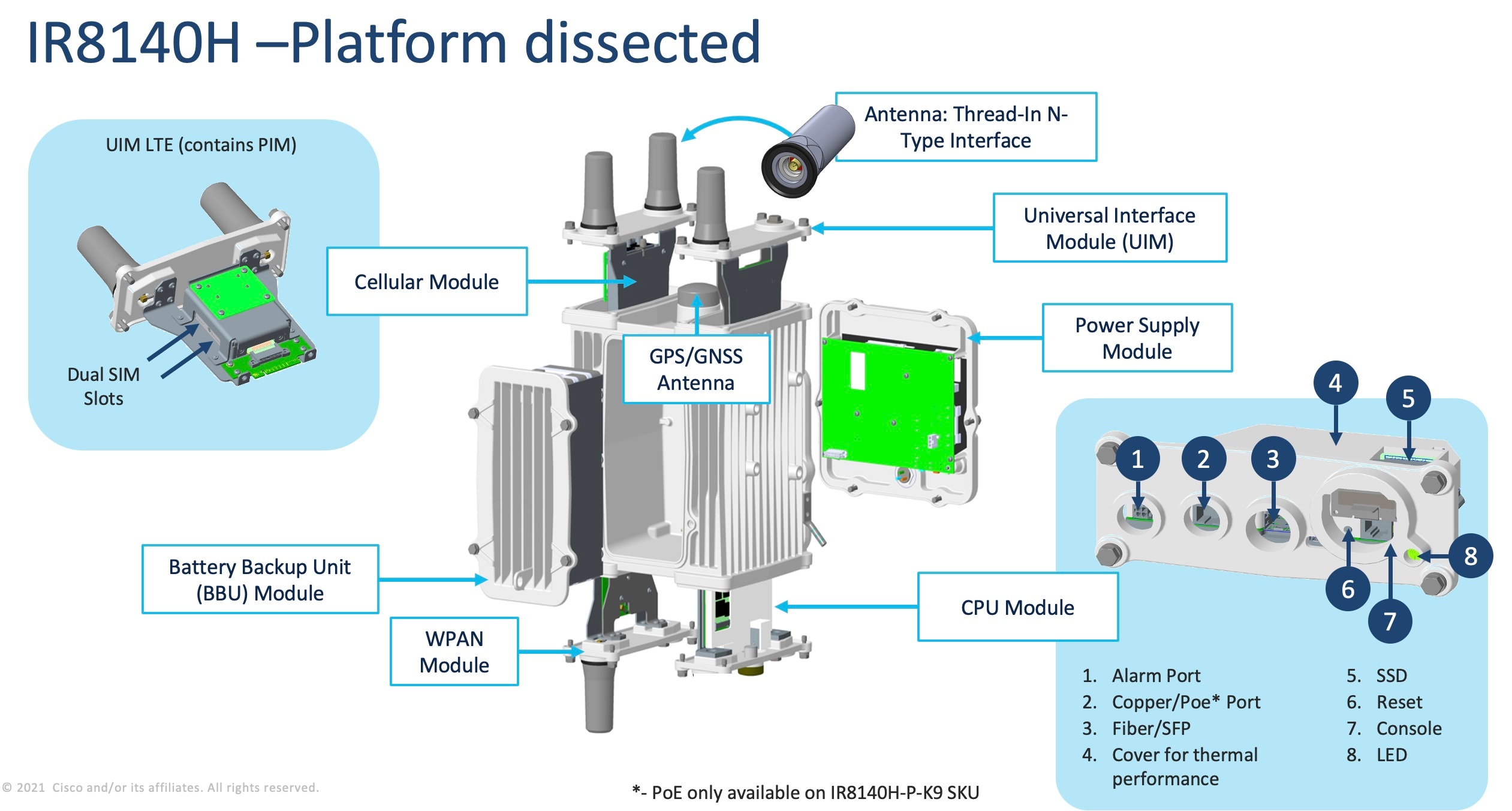
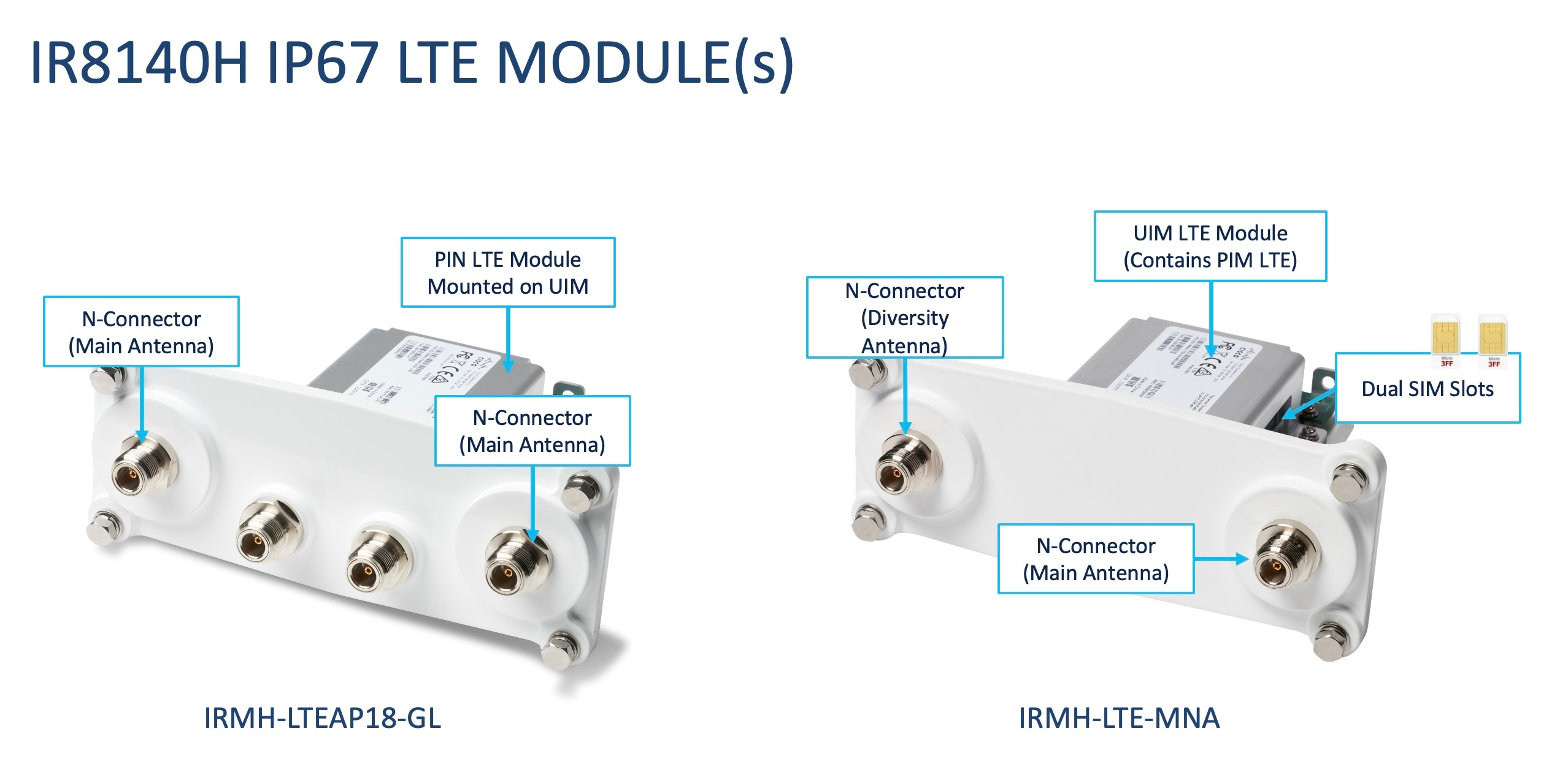
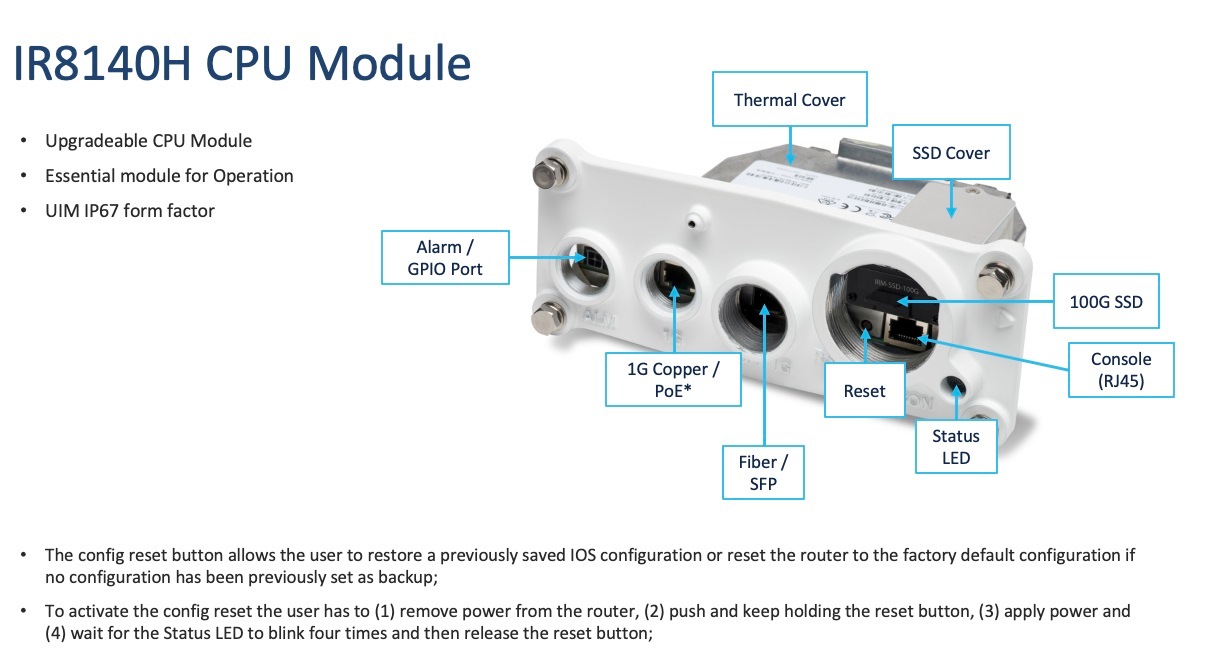
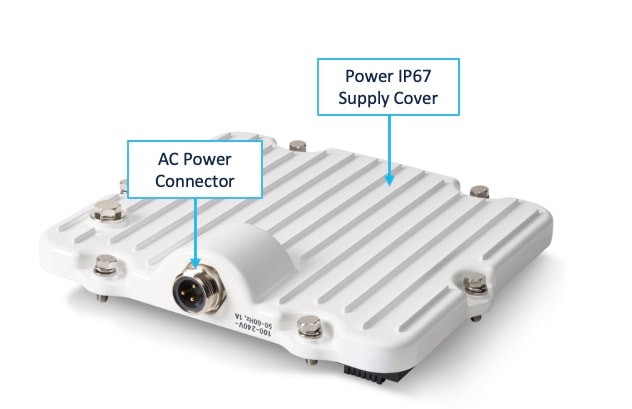
This table describes the different hardware components included in an IR8140:
|
Name |
Fixed or Modular |
Description |
|---|---|---|
|
Module Slot 0 |
Modular |
CPU module (contains Fiber + Copper ports |
|
Module Slot 1 |
Modular |
Typically houses the WPAN card |
|
Module Slot 2 |
Modular |
Typically houses the Cellular module |
|
Module Slot 3 |
Modular |
(Optional) 2nd Cellular or WPAN module |
All configuration operations are performed through either (1) the console port or (2) GigabitEthernet port GigabitEthernet 0/0/0 or Fiber GigabitEthernet0/0/1 (see Figure 3) . The console port uses a standard RJ45 console cable connected to the IR8140 console port on the CPU module located at the bottom of the IR8140 as shown in Figure 1. This console is configured to use the settings 9600/8/N/1.
Power is connected to a standard power outlet using the supplied power cord. IR8140’s software image is stored in the bootflash (eMMC).
In addition, a secondary eMMC storage for automatic file corruption recovery is added to this platform. This redundancy is critical because these systems are installed on utility poles, and to access and recover them otherwise will require a truck roll.
Software Differences: IR8140 vs CGR1000
The following sections describe the main differences between the configuration required on IOS XE software supported on IR8140H vs. IOS software supported on CGR1000. In addition, if more details are required about the configuration, visit Cisco Catalyst IR8140 Heavy Duty Series Router Software Configuration Guide.
Installation
CGR1240H follows this order of boot sequence:
-
Power on
-
Hypervisor Image (Rommon-1>)
-
System image (Rommon-2>)
-
Normal Operation for IOS
In contrast, IR8140H follows this order of boot sequence:
-
Power on
-
System image (Rommon>)
-
Normal Operation for IOS XE
Licensing
The CGR1240 is ordered usually with the SL-CGR1k-SEC-K9 license, and there is no need to do any configuration on the router. Currently, ordering of CGR1240 security license is from CCW (Cisco Commerce Workspace):
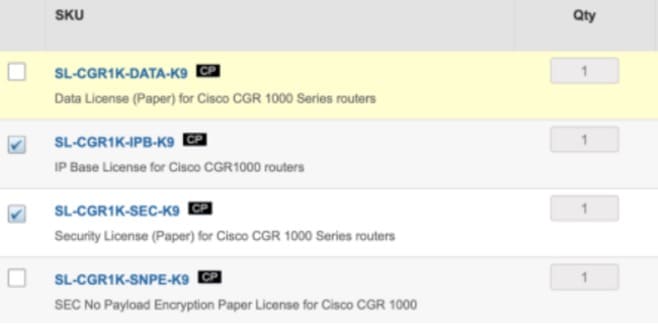
In IR8140H, WPAN and Mesh Management requires a Network-Advantage license to recognize the WPAN and enable the mesh security feature. For the use cases that require higher throughput ( >200 MB), it necessitates HSEC license in additional to the boost license to get more than 200 MB encrypted traffic. Order the Network-Advandage and HSEC license from CCW:
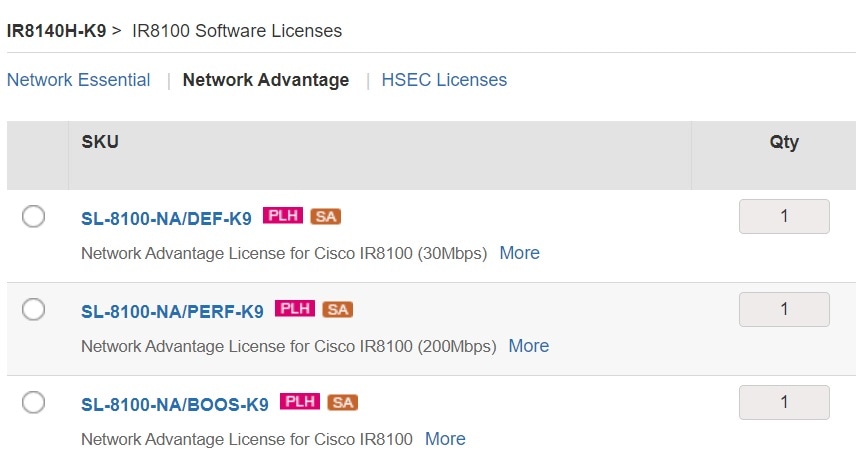
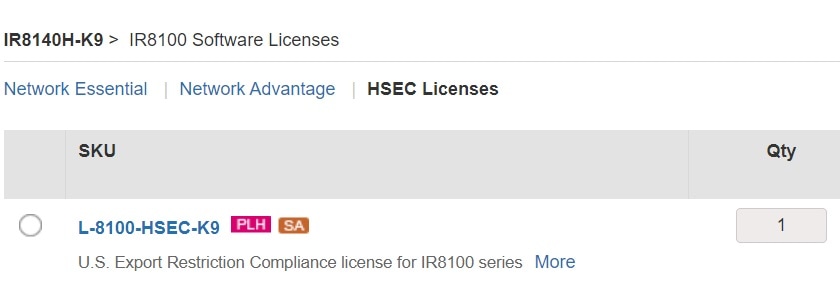
User must enable Advandage license on IOS XE and install HSEC, if it is not installed on the router.
IR8140H(config)#license boot level ?
network-advantage License Level Network-Advantage
network-essentials License Level Network-Essentials
IR8140H(config)#license boot level NEtwork-Advantage
% use 'write' command to make license boot config take effect on next boot
IR8140H#wr
After reload:
IR8140H#show license summary
License Usage:
License Entitlement Tag Count Status
-----------------------------------------------------------------------------
network-advantage_2G (IR8100_P_2G_E) 1 IN USE
IR8100 HSEC (IR8100_HSEC) 0 NOT IN USE
FND Licensing
IR8100 requires an “IOTFND-IR8100” license type on FND to start managing devices.
IR8140 FND License:
Subscription PID:
Top line PID: IOTFND-SOFTWARE-K9
1/3/5 Year options: IOTFND-IR8100
Top line PID: IOTFND-SUB-K9-10
10-Year Option: IOTFND-IR8100-10
CGR1240 FND License:
Perpetual PID:
Top line PID: IOT-FND
Perpetual PID: L-IOTFND-CGR1000
Subscription PID:
Top line PID: IOTFND-SOFTWARE-K9
1/3/5 Year options: IOTFND-CGR1000
Top line PID: IOTFND-SUB-K9-10
10-Year Option: IOTFND-CGR1000-10
FND/TPS Certificates for IR8140 Management
All communications between the managed routers and the Cisco IoT Field Network Director (IoT FND) must be authenticated in both directions through mutual authentication. Before mutual authentication occurs, the Cisco IoT FND and the device must each have a certificate signed by the same Certificate Authority (CA). The certificates for TPS and FND must be added to their respective keystores. See FND Installation Guide for step-by-step instructions.
If the FND server managed CGOS-based CGR1000 routers, the FND and TPS servers’ certificates likely contained OIDs for Command Authorization Support.
Due to stricter TLS implementation of the IR8140, these OIDs will cause failure during HTTP/SSL handshake during FND provisioning.
For a fresh installation of FND, ensure that certificates for the FND and TPS servers are generated without the OIDs for command authorization support.
If upgrading from a previous version of FND that supported CGOS routers, new certificates for the TPS and FND will have to be issued without the OIDs and updated in the respective cgms_keystore files to support IR8140 management.
Support for Dual WPAN
IR8140 supports up to two WPAN modules. While in CGR1240, we support just one module.
SNI Migration
This section providing information about SNI migration.
NPS and AAA requirements
NPS server policy needs to be modified wherever the string CGR1240 is used to match policies to authenticate the device – the PID (Product Identifier) needs to be updated to IR8140. Keep in mind that the PID of the PoE version is IR8140H-P-K9, and the Non-PoE is IR8140H-K9.
Refer to CGR1000 guide for enrollment if needed :
In particular, pay attention to step 13 in section “Defining a Connection Policy”– In Attribute manipulation rule, enter the appropriate PID+SN for the IR8140.
SCEP and RA configuration
With IOS CGRs – the RA was using CISCO SUDI (Secure Unique Device Identifier) with 2029 expiry. For IR8140, the SUDI has been updated to use 2099 expiry. This means that the RA will need to support both SUDI authentications temporarily until the migration to IR8140 is complete. The following configuration is an example to support both SUDI types on ISR4431 version 17.4.1:
Create a trustpoint “CA IR8140_SUDI_CA” containing the SUDI 2099 certificate:
crypto pki trustpoint IR8140_SUDI_CA
enrollment terminal
exit
crypto pki authenticate IR8140_SUDI_CA
-----BEGIN CERTIFICATE-----
MIIEZzCCA0+gAwIBAgIJCmR1UkzYYXxiMA0GCSqGSIb3DQEBCwUAMC0xDjAMBgNV
BAoTBUNpc2NvMRswGQYDVQQDExJDaXNjbyBSb290IENBIDIwOTkwIBcNMTYwODEx
MjAyODA4WhgPMjA5OTA4MDkyMDU4MjdaMDExHzAdBgNVBAMTFkhpZ2ggQXNzdXJh
bmNlIFNVREkgQ0ExDjAMBgNVBAoTBUNpc2NvMIIBIjANBgkqhkiG9w0BAQEFAAOC
AQ8AMIIBCgKCAQEAvdzeSWdDI6lRZDYRvA6JqaRvQyy6Dx1WaqI82UeKR4ZRn0ef
xMGvp4c88/VMS8WSjQO1qolMfMxqHkcSiFBOULx6Trquw4TrEf9sIuzvgJvDaEa8
IllXPwtPtNqZEIWi8jlinz2uGam93KuGPcioHfruzbDKWHL/HWFGYMgz+OKwhD3J
4NRySknQvUovfV8eWLeVOqW8rbnG3TZxv5VexOiK4jL3ObvsQPuAWUwUoo7nuFlE
GTG/VCeyCe/H8+afIScbZOkI9xejtckflnBYFVCyFxzm2H3YZatb6ohbyRXLtOPj
T3SJ+OOoYMlSLd28z727LpRbFFLGYhyWxEXDuQIDAQABo4IBgjCCAX4wDgYDVR0P
AQH/BAQDAgEGMBIGA1UdEwEB/wQIMAYBAf8CAQAwfwYIKwYBBQUHAQEEczBxMEEG
CCsGAQUFBzAChjVodHRwczovL3d3dy5jaXNjby5jb20vc2VjdXJpdHkvcGtpL2Nl
cnRzL2NyY2EyMDk5LmNlcjAsBggrBgEFBQcwAYYgaHR0cDovL3BraWN2cy5jaXNj
by5jb20vcGtpL29jc3AwHwYDVR0jBBgwFoAUOJVXDzQjTvOhJiC6FJHHQYgdo1sw
UgYDVR0gBEswSTBHBgorBgEEAQkVAR4AMDkwNwYIKwYBBQUHAgEWK2h0dHA6Ly93
d3cuY2lzY28uY29tL3NlY3VyaXR5L3BraS9wb2xpY2llcy8wQwYDVR0fBDwwOjA4
oDagNIYyaHR0cDovL3d3dy5jaXNjby5jb20vc2VjdXJpdHkvcGtpL2NybC9jcmNh
MjA5OS5jcmwwHQYDVR0OBBYEFOpro7nBE5d+G/s6jWhgBzlfh0j6MA0GCSqGSIb3
DQEBCwUAA4IBAQBcqYEOgAHhGWKndwM901XX2Enh4hjXR5avDg7G/f6Tb9H509dt
QW+AeZGEghhwUrw1EeG79tHkncAe+m+64xMC1ttyI1RSyn8rBqQYkXnnCRbtF/Nw
pQe5fjvdeIFWJhUI16TOt/ZlkNnWnLsUU1alZmN+J/FhSr8VTJWGRM9gY8hefH8f
5U7LMiDXxsFVHB7R6KGNjvtawrl6W6RKp2dceGxEIIvMahgMWWHHiWOQAOtVrHuE
NEjYR/7klLLwdgQF/NNCA2z47pSfMFnBcr8779GqVIbBTpOP2E6+1pBrE2jBNNoc
uBG1fgvh1qtJUdBbTziAKNoCo4sted6PW2/U
-----END CERTIFICATE-----
quit
Trustpoint 'IR8140_SUDI_CA' is a subordinate CA and holds a non self signed cert
Certificate has the following attributes:
Fingerprint MD5: E6897BC6 27D7C558 A2330EC7 C2D7A10B
Fingerprint SHA1: F81D5550 D67DCD1D D11192B5 7F8FDE09 A4A569B7
% Do you accept this certificate? [yes/no]: yes
Trustpoint CA certificate accepted.
% Certificate successfully importedYou can check it via the following:
show crypto pki certificate verbose IR8140_SUDI_CAChange the grating trustpoint to a tp-list:
configure terminal
crypto pki server UTILITY_RA
no grant auto trustpoint ACT2_SUDI_CA
grant auto tp-list ACT2_SUDI_CA IR8140_SUDI_CAIMPORTANT: It is required to no the “auto trusthpoint” and then add the “auto tp-list” as they are mutually exclusive. Also, the trustpoint names are “space” delimited.
Refer to Configuring Certificate Renewal by Enabling Multiple Trustpoints for more information.
IDevID Certificate and Subject Alternative Names
 Note |
If using a CN.<domain name> in the CSR signing , please make sure the signing CA is equipped to handle alternate names. The IR8140H will auto-create a subject-alt-name line for the router under the LDevID trustpoint if a domain name is added to the CN . |
Example:
subject-name serialNumber=PID:IR8140H-K9 SN:FDO2515JD0B,CN=IR8140.cisco.com
subject-alt-name IR8140.cisco.com
FND State machine, Firewall ports, and ZTD
The TLS (Transport Layer Security) default ports is being changed to 443 from 8443 for FND mutual HTTPS auth on IOS XE. FND communicates with IOS XE using port 443.
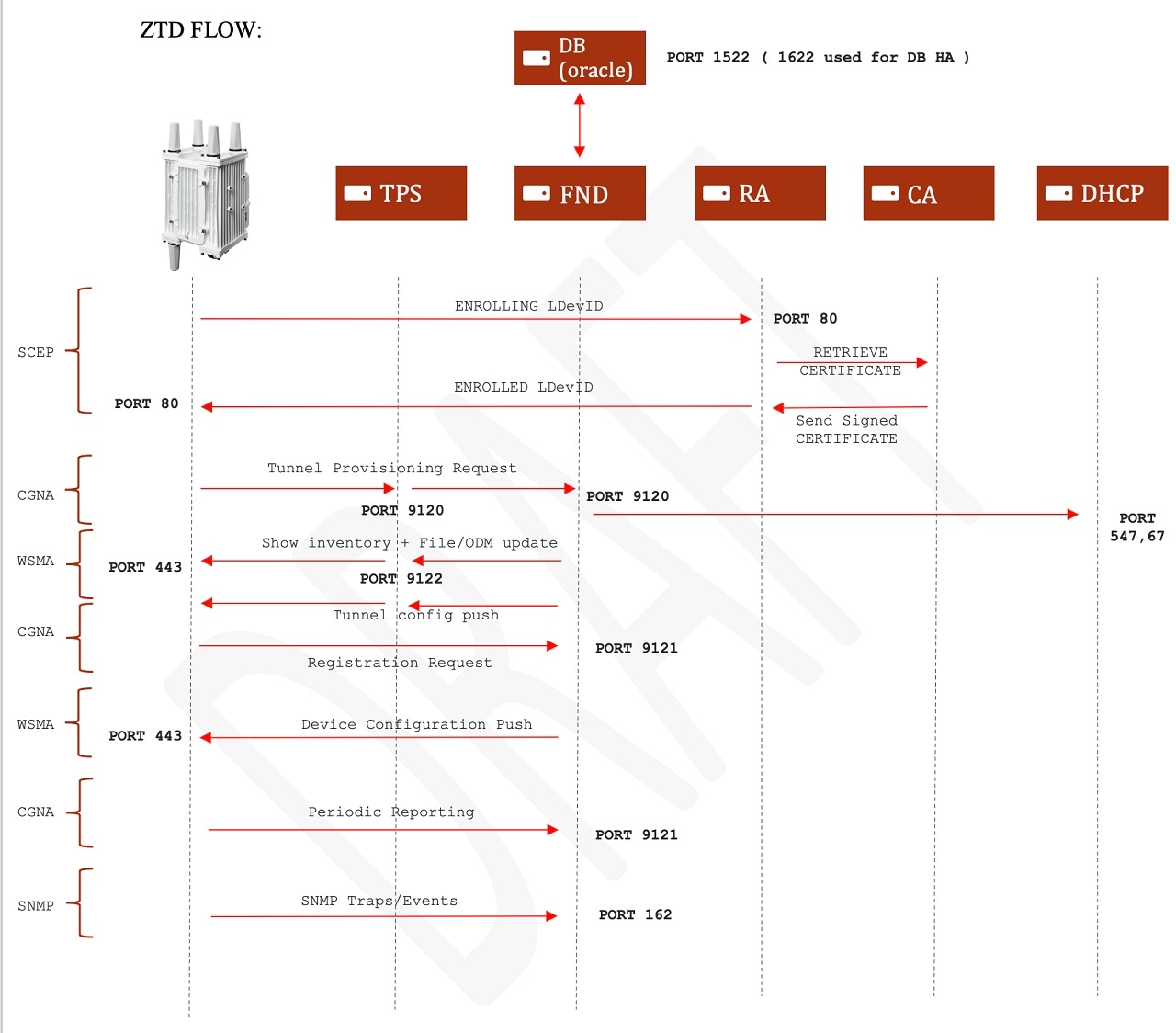
Notice of Shipment File (Requirements) (Min FND version 4.8)
FND defines and classifies the IR8140 as an IR8100 ‘deviceType’, as a results all properties and groups in FND carry forward the principles of defining separate groups for the device.
To create notice of shipment file to add to FND ( CSV or XML ) :
Mandatory Fields ( red required for Provisioning Tunnels from FND ):

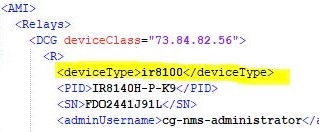
If you use the userPropertyType.xml in /opt/cgms/server/conf/userPropertyTypes.xml, you'll need to update it by adding the ir8100 as a device type.
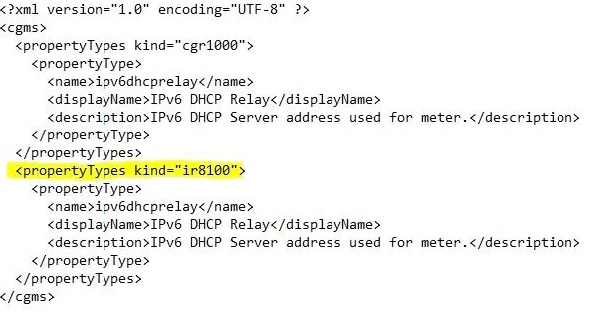
Examples of FND Template for IR8140 AMI Use Cases
These are examples of the templates used by our solution and services teams to deploy the router. For reference only.
-
Tunnel Template (This template will handle both CGRs and IR8100s.)
<#if far.eid?contains("IR81") || far.eid?contains("IR11")> <#assign isRunningIosXe=true> <#else> <#assign isRunningIosXe=false> </#if> <#if !(far.ipsecTunnelDestAddr1??)> ${provisioningFailed("FAR property ipsecTunnelDestAddr1 is undefined.")} </#if> aaa authorization network FlexVPN_Author local crypto pki certificate map FlexVPN_Cert_Map 1 issuer-name co cn = FANRSACA.cisco.com <#if !(far.dhcpV6LoopbackLink??)> ${provisioningFailed("FAR property dhcpV6LoopbackLink is undefined.")} <#else> ipv6 unicast-routing <#if !isRunningIosXe> ipv6 cef </#if> interface Loopback0 ipv6 address ${far.ipv6Address(far.enDuid,0,far.dhcpV6LoopbackLink).address}/128 interface Tunnel10 ipv6 unnumbered Loopback0 ipv6 mtu 1280 ipv6 tcp adjust-mss 1240 </#if> <#if (far.meshPanidConfig??)> <#if !far.eid?contains("IR81")> ipv6 access-list bmr-prefix permit ipv6 2001:abcd:1::/56 any route-map conn2Ikev2 permit 10 match ipv6 address bmr-prefix route-map conn2Ikev2 permit 20 match interface loopback0 wpan4/1 crypto ikev2 authorization policy FlexVPN_Author_Policy route redistribute connected route-map conn2Ikev2 <#else> ipv6 access-list local-prefixes permit ipv6 ${far.meshPrefixConfig}/${far.meshPrefixLengthConfig} any permit ipv6 2001:abcd:1::/56 any crypto ikev2 authorization policy FlexVPN_Author_Policy route set interface route set access-list ipv6 local-prefixes </#if> <#else> crypto ikev2 authorization policy FlexVPN_Author_Policy route set interface </#if> crypto ikev2 proposal FlexVPN_IKEv2_Proposal encryption aes-cbc-256 integrity sha256 group 19 crypto ikev2 policy FLexVPN_IKEv2_Policy proposal FlexVPN_IKEv2_Proposal crypto ikev2 profile FlexVPN_IKEv2_Profile match certificate FlexVPN_Cert_Map identity local dn authentication remote rsa-sig authentication local rsa-sig pki trustpoint LDevID no lifetime certificate dpd 30 3 on-demand aaa authorization group cert list FlexVPN_Author FlexVPN_Author_Policy crypto ikev2 fragmentation mtu 1000 crypto ikev2 redirect client crypto ikev2 nat keepalive 10 crypto ipsec transform-set FlexVPN_IPsec_Transform_Set esp-aes 256 esp-sha256-hmac mode transport crypto ipsec profile FlexVPN_IPsec_Profile set security-association lifetime days 1 set transform-set FlexVPN_IPsec_Transform_Set set pfs group19 set ikev2-profile FlexVPN_IKEv2_Profile interface Tunnel10 description to ${her.eid} tunnel source ${far.tunnelSrcInterface1} tunnel destination dynamic tunnel protection ipsec profile FlexVPN_IPsec_Profile crypto ikev2 client flexvpn VPN_LB peer 1 ${far.ipsecTunnelDestAddr1} client connect Tunnel10 -
Configuration Template
<#-- If a Loopback0 interface is present on the device (normally configured during tunnel provisioning) then use that as the source interface for the HTTP client, SNMP traps and RADIUS protocol. The source for the HTTP client is not changed during tunnel provisioning because usually the addresses assigned to the loopback interface are only accessible through the tunnels. Waiting insures the tunnel is configured correctly and comes up. --> <#if far.interfaces("Loopback0")?size != 0> ip http client source-interface Loopback0 snmp-server trap-source Loopback0 ipv6 radius source-interface loopback0 </#if> <#-- Enable periodic inventory notification to report metrics. --> cgna profile cg-nms-periodic interval 60 exit <#-- Enable periodic configuration (heartbeat) notification. --> cgna heart-beat interval 20 <#-- Interfaces configuration --> interface ${far.tunnelSrcInterface1} no ip redirects no ip unreachables no ip proxy-arp line console 0 exec-timeout 5 line vty 0 4 exec-timeout 5 transport input ssh transport output none service nagle no service pad service tcp-keepalives-in service tcp-keepalives-out service timestamps debug datetime msec localtime service timestamps log datetime msec localtime service password-encryption service sequence-numbers no ip source-route no ipv6 source-route no ip gratuitous-arps no ip bootp server no cdp run no ip finger no boot network ip tcp synwait-time 5 ip tcp path-mtu-discovery ip tcp mss 1460 <#if (far.meshPrefixConfig??)> radius server fanheradius address ipv6 fd10::1:10 auth-port 1812 acct-port 1813 key rhHHBiMZ aaa group server radius radius-group server name fanheradius aaa authentication dot1x default group radius-group dot1x system-auth-control ipv6 multicast-routing ipv6 multicast pim-passive-enable ipv6 pim rp-address fd10::2:20a <#if far.meshPrefixConfig?matches(".*::.*")> <#assign mcastAddress="ff38:40:${far.meshPrefixConfig}"+"1"> <#else> <#assign sublist=far.meshPrefixConfig?split(":")[0..5]> <#assign mcastAddress="ff38:40:"+sublist[0]+":"+sublist[1]+":"+sublist[2]+":"+sublist[3]+"::1"> </#if> int loopback 0 ipv6 mld join-group ${mcastAddress} ipv6 pim passive interface Wpan0/1/0 no ip address ip broadcast-address 0.0.0.0 ieee154 beacon-async min-interval 10 max-interval 60 suppression-coefficient 1 ieee154 panid ${far.meshPanidConfig} ieee154 phy-mode 2 ieee154 ssid Mesh ieee154 phy-mode 66 166 <<< needed only for WISUN mode deployment ieee154 beacon-ver-incr-time 0 <<< needed only for WISUN mode deployment wisun-mode <<< needed only for WISUN mode deployment dtls-relay fd10::1:13 port 61629 max-sessions 20 lifetime 120 rpl dag-lifetime 60 rpl dio-min 15 rpl dio-dbl 2 rpl version-incr-time 10 outage-server fd10::1:d authentication host-mode multi-auth authentication port-control auto ipv6 address ${far.meshAddressConfig}/64 ipv6 enabled ipv6 dhcp relay destination fd10::1:b no ipv6 pim dot1x pae authenticator mesh-security max-active-key-exchange 10 mesh-security max-active-authentication 15 mesh-security authentication-timeout 45 no shut </#if> <#-- Enable BBU (Battery Backup Unit) discharge if one is present --> <#if far.hasActiveBattery()> do request platform hardware battery enable </#if> Add section for CRM END OF CONFIGURATION
Frequently Asked Questions
Certificates Used in Cisco Industrial Solution
|
Certificate Name |
Source |
Signed By |
Installed By |
Manufacturing Process |
Required By |
|---|---|---|---|---|---|
|
IDevID |
Generated by Cisco |
Cisco CA |
Cisco Manufacturing |
Pre-configured |
Cisco Identification of Device, SCEP |
|
Customer Issuer CA Certificate |
Generated by customer CA. Needs to be delivered to manufacturing. |
Customer root CA |
Partner |
Manually imported or dynamically during SCEP |
CGNA, FND, IKEv2 |
|
LDevID |
Option 1: Generated by FAR |
Customer Issuer CA |
FAR via SCEP Process in the field |
Partner enters SCEP Provisioning Commands |
CGNA, FND, IKEv2 |
|
Option 2: Generated off-box by Utility CA on behalf of the FAR using FAR’s unique information (product id + serial no) |
Partner |
Generated and imported via script. |
Common Commands that are different on IR8140
Some commands are different because of the new OS – IOS-XE.
Reload modules:
IR8140#show platform
Chassis type: IR8140H-P-K9
Slot Type State Insert time (ago)
--------- ------------------- --------------------- -----------------
0 IR8140H-P-K9 ok 2w5d
0/0 IR8140H-2x1GE ok 2w5d
0/1 IRMH-WPAN-NA ok 2w5d
0/2 IRMH-LTEA-LA ok 2w5d
R0 IR8140H-P-K9 ok, active 2w5d
F0 IR8140H-P-K9 ok, active 2w5d
P0 IRMH-PWR60W-AC ok 2w5d
Eg: reloading a cellular module:
IR8140(config)#hw-module subslot 0/2 ?
3rdparty-mode Assign this slot for 3rd-party module
battery-mode Power-off the target subslot when powered by backup-battery
shutdown Shutdown the target subslot
IR8140(config)#hw-module subslot 0/2 shutdown unpowered
IR8140(config)#no hw-module subslot 0/2 shutdown unpowered
OR
IR8140#hw-module subslot 0/2 reload
GPS:
IR8140H#show platform hardware gnss details
GNSS details:
Status: GNSS fix acquired
Time: 2023-01-10 17:08:55 UTC
Latitude: 37 Deg 25 Min 6.075 Sec North (37.418354)
Longitude: 121 Deg 55 Min 9.58 Sec West (-121.919327)
Height: 26.4m
Fix type: 3D PDOP: 1.58 HDOP: 1.04 VDOP: 1.18
Total RMS standard deviation: NA
Latitude error: 6.1m Longitude error: 6.0m Altitude error: 13.0m
GPS:
6 satellites used for fix: 3, 4, 7, 9, 26, 31
13 satellites in view
ID = 01 elevation = 05 azimuth = 199 CN0 = 10
ID = 03 elevation = 65 azimuth = 174 CN0 = 27
ID = 04 elevation = 66 azimuth = 344 CN0 = 21
ID = 06 elevation = 17 azimuth = 300 CN0 = 21
ID = 07 elevation = 25 azimuth = 239 CN0 = 26
ID = 09 elevation = 36 azimuth = 302 CN0 = 25
ID = 11 elevation = 00 azimuth = 331 CN0 = NA
ID = 16 elevation = 46 azimuth = 113 CN0 = 17
ID = 22 elevation = 04 azimuth = 093 CN0 = 11
ID = 26 elevation = 36 azimuth = 063 CN0 = 23
ID = 31 elevation = 05 azimuth = 052 CN0 = 18
ID = 46 elevation = 46 azimuth = 192 CN0 = NA
ID = 48 elevation = 46 azimuth = 185 CN0 = NA
GLONASS:
1 satellites used for fix: 76
10 satellites in view
ID = 65 elevation = 00 azimuth = 124 CN0 = NA
ID = 67 elevation = 58 azimuth = 350 CN0 = 20
ID = 68 elevation = 14 azimuth = 317 CN0 = NA
ID = 76 elevation = 40 azimuth = 036 CN0 = 23
ID = 77 elevation = 79 azimuth = 144 CN0 = NA
ID = 78 elevation = 24 azimuth = 201 CN0 = NA
ID = 82 elevation = 02 azimuth = 254 CN0 = NA
ID = 83 elevation = 09 azimuth = 294 CN0 = NA
ID = 84 elevation = 01 azimuth = 349 CN0 = NA
ID = 92 elevation = 14 azimuth = 316 CN0 = NA
GALILEO:
3 satellites used for fix: 5, 9, 36
11 satellites in view
ID = 01 elevation = 06 azimuth = 034 CN0 = NA
ID = 03 elevation = 05 azimuth = 291 CN0 = NA
ID = 04 elevation = 13 azimuth = 099 CN0 = NA
ID = 05 elevation = 52 azimuth = 314 CN0 = 26
ID = 09 elevation = 59 azimuth = 068 CN0 = 17
ID = 15 elevation = 09 azimuth = 320 CN0 = NA
ID = 24 elevation = 47 azimuth = 154 CN0 = 17
ID = 25 elevation = 06 azimuth = 193 CN0 = NA
ID = 31 elevation = 47 azimuth = 074 CN0 = 21
ID = 34 elevation = 21 azimuth = 271 CN0 = 18
ID = 36 elevation = 12 azimuth = 220 CN0 = 14
NTP:
Hardware clock is automatically updated from NTP server configured without "ntp update-calendar" command in global configuration.
BBU:
You can use the following command to enable or disable BBU:
request platform hardware battery {enable | disable }
Use the following command to show BBU status:
show platform hardware battery {brief | details | event-log | pins | short | sprom | unit }
Setup WPAN (IRMH-WPAN-NA) to Function Like CGR WPAN (CGM-WPAN-FSK-NA)
The IRMH-WPAN-NA supports various physical protocols. Select FSK for compatibility with CGR WPAN modules. Please see template examples for further information.
Adding WPAN configuration is the same as CGR:
interface Wpan0/1/0
ieee154 phy-mode 2Minimal setup:
!
interface WPAN0/1/0
no ip address
no shutdown
ieee154 phy-mode 2
ieee154 panid 9016
ieee154 ssid sqaFT06
outage-server 2620:CB:0:1006:1480:100:0:131
ipv6 address 2620:CB:0:9016::/64
ipv6 enable
ipv6 dhcp relay destination 2620:CB:0:1006:1480:100:0:221
authentication host-mode multi-auth
authentication port-control auto
dot1x pae authenticator
no mop enabled
no mop sysid
! Troubleshooting
ISSUE: PKIX path validation failed
Log:
5801: localhost.localdomain: Oct 25 2022 14:38:21.642 +0000: %IOTFND-3-UNSPECIFIED:
%[ch=CiscoIosTunnelProvServlet$CiscoIosTunnelProvProcess][eid=IR8140H-K9+FDO2515JDBU]
[ip=10.236.2.2][sev=ERROR][tid=IOS CGR Tunnel-1]:
Tunnel provisioning request for element [IR8140H-K9+FDO2515JDBU] failed [javax.xml.ws.soap.SOAPFaultException:
sun.security.validator.ValidatorException: PKIX path validation failed:
java.security.cert.CertPathValidatorException: validity check failed].
75802: localhost.
Solution:
Subbordinate or signing CA must have an alias in the keystore of “subca”:
keytool -import -trustcacerts -alias subca -keystore cgms_keystore -file subca.pem Feedback
Feedback